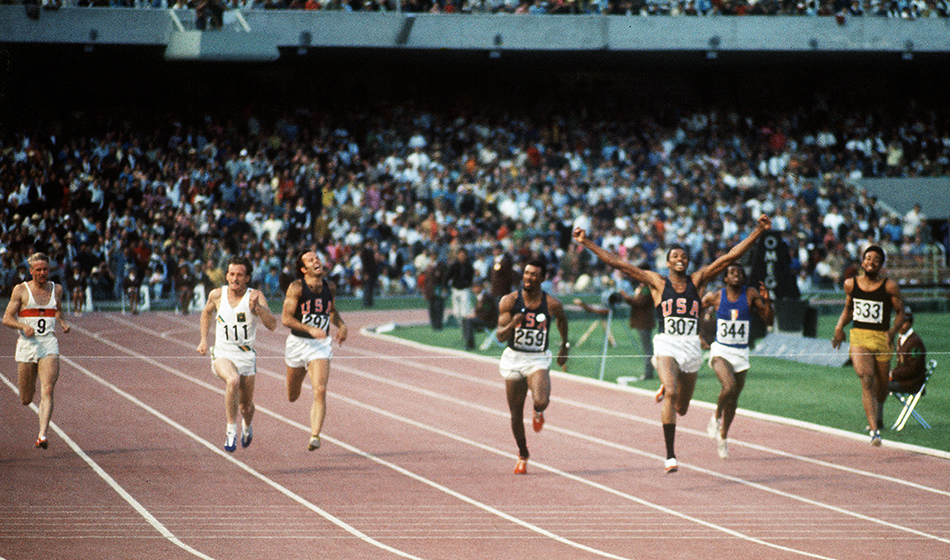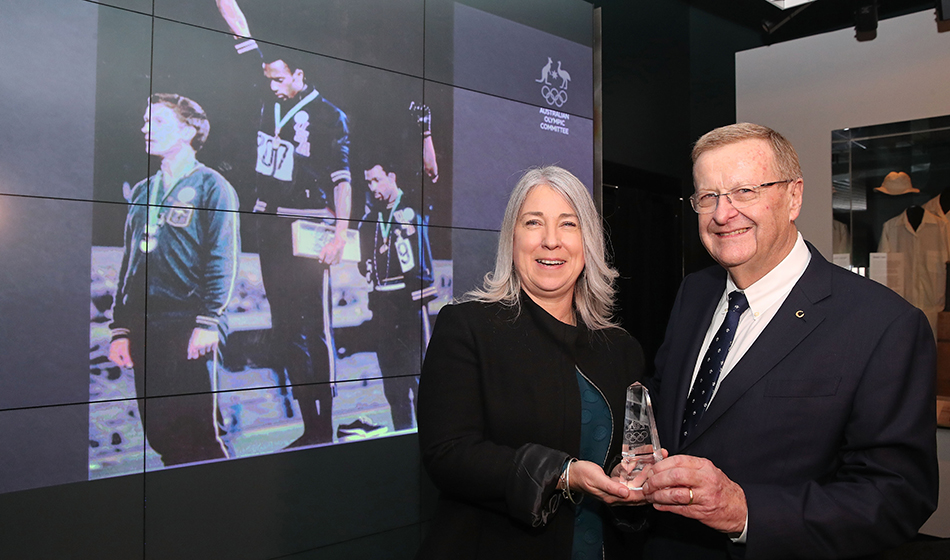While Tommie Smith and John Carlos have become known throughout the world for their black power salute at the 1968 Olympics, the athlete who stood with them in support on the podium has been less celebrated. In his new book, Doug Levy examines that story
When the moment in time came to decide what was right, Peter Norman chose human rights. Peter Norman? To knowledgeable sports fans, it is a name that will ring the faintest of bells – if it rings one at all. Understandable on one hand, yet sad on the other.
It has been over a half century since he first won acclaim as a guy who could run very, very fast. His story unfolded on October 16, 1968 at the Olympic Games in Mexico City. The fame he received for his 200m silver medal is not the distressing part of his journey. Instead, it’s the sorrowful lack of awareness of his role after the race concluded.
Many people recall, or have heard about, Tommie Smith and John Carlos on the 200m podium, their dark-gloved hands raised skyward in salute to Black power and human rights. Often forgotten or overlooked are Peter’s ideas and actions, depicting him as a civil rights trailblazer who stood with them.
“In a way, his story is more important than Tommie and John’s,” said Matt Norman, Peter’s nephew.
Peter’s story is also a complex one. There is little in dispute about what he did on that October day and why it mattered. The stuff of disagreement lies in what happened to him afterwards, the treatment he received, and how long it took for him to be duly recognised. Sadly, the debate has endured without Peter’s own voice; he died of a heart attack in 2006. It has since been left to others to dissect the details and to determine, in their own minds, whether or how much Peter suffered for his actions at that Mexico City medal ceremony.
In the race itself, Smith won in a world record of 19.83. Peter, brandishing his fearsome finishing kick, took silver in 20.06. Carlos settled for bronze in 20.10.
But to foreshadow the importance of what Peter then did on the walk up to, and on, the podium, it is helpful to dial back to what had preceded those Games. African American leaders had threatened a boycott; after all, racial tensions had boiled in the months since Martin Luther King Jr. had been assassinated in Memphis. While the boycott was called off, civil rights leader Harry Edwards did orchestrate a series of protests to elevate the cause of racial equality at the Olympics.
The plan was for Smith and Carlos to be two of the key baton-carriers for spotlighting the need for racial justice in front of an Olympic-size crowd. Peter pumped more fuel into the effort. A few minutes after his legs took him 200m in just over 20 seconds, he made rapid-fire decisions with his conscience and his mind. Taken together, they screamed “human rights ambassador” much louder than “fastest white guy in the world.”
It was Peter who had learned of the gesture Smith and Carlos had at the ready and who had said: “I’ll stand with you.” It was Peter who, upon learning that Smith had only two black gloves for their post-race demonstration rather than the four they had planned on, suggested each of the two men wear and raise a single glove. They agreed. And it was Peter who, seeing a member of the US crew team walk by wearing an “Olympic Project for Human Rights” button, asked if he could wear it on the podium.
If it doesn’t seem like Peter’s actions that day had the potential to be world-altering, well, let’s put a magnifying glass back on the social and civil unrest around the globe back then.
In 1968, Black Americans were just a few years removed from having been told they could not eat at the same restaurants, drink from the same water fountains, or sit in the same section of a public bus as white people.
Apartheid raged in South Africa. Aboriginal people in Australia suffered much the same racial indignation and had not been recognised as Australian citizens with full voting rights until 1962.
The stakes were different for Peter than they were for Smith and Carlos. The two African American sprinters had a cause to spotlight, and they were all in. Peter had a belief that the cause was just, and he joined the demonstration in his own way. But he must have instinctively known he would not be celebrated for it.
As Matt said: “The world was dealing with massive racial issues – the assassinations of [Robert F.] Kennedy and MLK [Jr.], the treatment of aboriginals – for Peter to stand up as he did was remarkable to me.”
It was not the usual set of actions for a Caucasian athlete, or any white man of the late 1960s, to take. “That’s what makes it so incredible – it just wasn’t done,” said his daughter, Janita. “He had to be incredibly courageous, and he did act out of his beliefs.”

While Peter’s post-race actions triggered some negative blowback, they didn’t stain his standing with Athletics Australia officials – at least not in the immediate aftermath. However, things got messy for him.
One bone of major contention involved the 1972 Olympic Trials for Australian sprinters and the choice of who to take to the Summer Games in Munich. Athletics Australia had a qualifying standard of 20.9 for the 200m. Peter had beaten that plenty of times, but in the country’s Olympic Trials in Perth – competing on an injured knee – he took third place in 21.6.
Did a 30-year-old Peter simply fail to summon up a good enough performance at the very time he needed to? Or had his post-race Mexico City actions somehow gotten in his way?
Strath Gordon, the chief of public affairs for the Australian Olympic Committee (AOC), said Peter’s failure to qualify was not a reflection on his actions in Mexico City. “He was injured and at the end of his career. He ran a poor time.”
In that same vein, a post-Olympic Trials article from The Age, a daily newspaper in Melbourne, quoted Peter as saying: “I’m history. I’m out of the team.” The reporter, Ron Carter, also wrote that Peter “probably ran himself out of the team”.
But there are more details to examine. In that same article in The Age, Carter noted that Peter had been nursing the aforementioned knee injury for weeks. “If the selectors do the right thing, Norman should still be on the plane to Munich. He has run 20.5 this season and is a good competitor. In Munich, he would do well.”
Then there was the confusion over what, if any, process existed on paper to guide Athletics Australia in its decision-making. In the book The Peter Norman Story, the authors quoted a national team selector, Paul Jenes, as saying: “There were no set criteria. You basically picked the best team.”
If that was the case, Matt said, wouldn’t it have made enormous sense to place Peter – Australia’s national record-holder, the 1968 silver medalist, and the world’s fifth-ranked 200m runner – on the team?
What made the whole saga even odder and murkier is the curious fact that the country wound up not taking any male sprinters to the 1972 Olympic Games. We don’t know what Peter would have done had he been in the field for Munich, but we do know that only one 200m sprinter in 1972, gold-medal winner Valeriy Borzov, ran a time faster than the one Peter recorded in Mexico City four years earlier.
More controversy crept up in 2000, when Australia hosted the summer Olympics in Sydney, and questions arose as to whether Peter was accorded the respect he deserved.
The way Gordon told it and the way International Olympic Committee vice president and then AOC president John Coates described it in The Peter Norman Story, Peter indeed received his just due. He ran a leg of Australia’s Olympic torch relay, served as an Australian Olympic Team ambassador at promotional events, and helped christen the Olympic medals that would be used for the 2000 Games during a gala at the Sydney Opera House.

But there were competing perspectives, with Matt and others believing Peter was slighted. Matt conveyed in our interview that while Peter did play a role in the lead-up to the 2000 Games, Australian officials didn’t invite him to any functions during the Games themselves. It seemed to be the United States, not Australia, that took extra steps to value Peter’s presence and to finance his attendance at events during the Sydney Games.
For example, a prominent USA Track and Field (USATF) official, Steve Simmons, arranged airfare for Peter to travel from his home in Melbourne to Sydney, where he was warmly embraced and applauded as a guest of the US Olympic Committee (USOC).
The USOC then flew Peter to a subsequent Olympic track and field trials. Years later, retrospective articles on Peter indicated he had been “shunned” in 2000 and not invited to events. Whether he was wrongly snubbed by not being selected for the Munich Games or overlooked and underappreciated during the 2000 Olympics – and whether any of that was an after effect of his 1968 stand – will almost surely remain an unsettled debate.
In 2006, just months after he had undergone a triple bypass surgery, he died of a heart attack. He was only 64. If Australia had been a little slow in recognising the positive impact of what he did, perhaps Peter’s funeral turned the tide.
In 2006, USATF arranged to mark October 9 – the day of the funeral – as “Peter Norman Day”. USATF official Steve Simmons indicated to reporters that it was unprecedented for the organisation to declare a day in honour of an athlete outside of the United States.
After Peter’s death, Australian officials established additional tributes for him. A transformative one came on October 11, 2012, through the efforts of Andrew Leigh, a member of Australia’s Parliament, who believed an official mea culpa was in order. Leigh’s motion of apology to Peter passed unanimously.
In 2018, the AOC awarded Peter with a posthumous Order of Merit, and on October 9, 2019, Athletics Australia and the Victorian government unveiled a statue in Peter’s honour in Melbourne’s city centre. Athletics Australia also established a Peter Norman Day to recognise his achievements.
Gordon admitted that praise and recognition for what Peter did in 1968 “should have come much earlier”. He added that: “Australia, like the US, has needed to come to terms with our past and our history… Peter clearly said he believed in human rights. He took a stand.”
This edited extract comes from Hero Redefined: Profiles of Olympic Athletes Under the Radar, which is available now at authordouglevy.com










